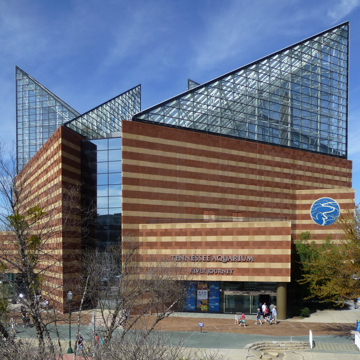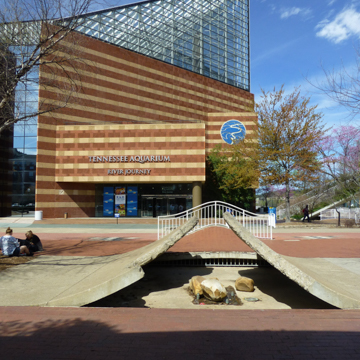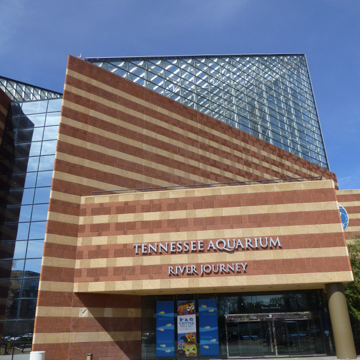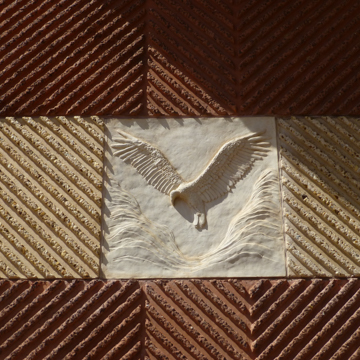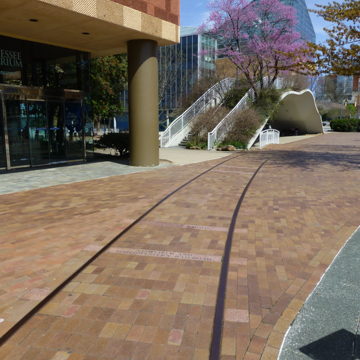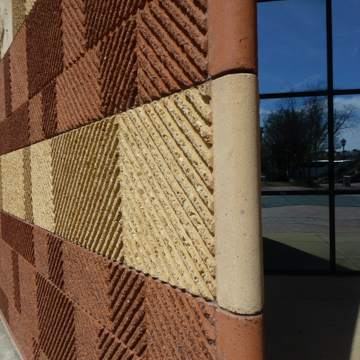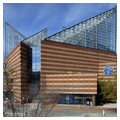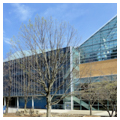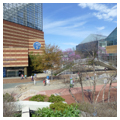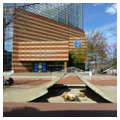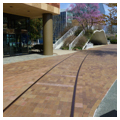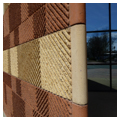You are here
Tennessee Aquarium
The Tennessee Aquarium is to the city of Chattanooga what the Pyramid Arena is to Memphis. Its distinctive crystalline glass roof dominates Chattanooga’s skyline in the riverfront area. More than merely iconic, the building was also a catalyst for urban renewal and became the nucleus of a tourist district.
The aquarium consists of two main buildings: “River Journey,” as the original structure is now called, opened in 1992. Dedicated to local river life, this building is defined by its striking triangulated glass roof. The adjacent “Ocean Journey,” the second building in the complex, opened in 2005 to highlight saltwater marine life and provide space for sharks, penguins, butterflies, and hundreds of other species. Together, the buildings display the progression of biological diversity from the headwaters of the Appalachians to the Gulf of Mexico.
The idea for an aquarium in Chattanooga arose in the mid-1980s when two community development groups, RiverCity Company and Chattanooga Venture, sponsored a master plan for the city focused on revitalization and redevelopment. Produced by Carr, Lynch Associates of Cambridge, Massachusetts, the plan called for the construction of an urban aquarium consisting of 45,000-60,000 square feet with an estimated cost of $30 million.
In early 1987 the task force announced its decision to award the design to the Cambridge Seven Associates (C7A). Founded in 1962 by designers and architects interested in collaborative, interdisciplinary projects, C7A was also based in Cambridge, Massachusetts. The principal founding architect, Peter Chermayeff, was joined in 1976 by Bobby Poole. From its beginnings C7A took on projects that combined urban planning, architecture, graphic design, art, and even film, and zoos, aquariums, science centers, and children’s museums became a specialty. The firm landed the Tennessee project on the strength of its two previous aquariums: the New England Aquarium in Boston (1969) and the National Aquarium in Baltimore (1981).
Like the Baltimore Aquarium, the Tennessee Aquarium features an off-center pyramidal glass roof projecting six stories above an angular concrete-sheathed base, also six stories. Below this roof are walls sheathed in 4,000 precast concrete panels, laid in alternating colored bands of brick red and sand. Each panel is deeply ribbed at 45-degree angles and laid in shifting patterns that enhance the play of sunlight and shadow. Embedded within the walls at regular intervals are cast stone panels relating the history of Chattanooga and its natural resources. Rounded concrete caps protect the acute angles of the building from chipping. Just beneath the glass roof is a terrarium dedicated to forest habitats. Lower floors hold the tanks for aquatic life. A “central canyon” extends through these lower floors to offer simultaneous views of multiple tanks, all in a dark, dramatically lit environment.
In 1993, largely on the strength of the Tennessee Aquarium, the AIA awarded C7A its Architecture Firm of the Year award. Five years later, C7A’s principal aquarium designers formed a new firm, Chermayeff, Sollogub and Poole, Inc. In 2001, this firm began work on “Ocean Journey,” a $30 million expansion that added tanks holding 750,000 gallons of water, nearly twice the capacity of the original aquarium building. The expansion also provided a three-story-high window wall offering striking views of the Tennessee River.
The expansion also included Ross’s Landing Park Plaza, two landscaped acres that surround and separate the aquarium buildings. With planning supervised by EDAW, the environmental design firm originally founded by Garrett Eckbo and Edward Williams, the plaza includes brass plaques, concrete pavers, locomotive rails, and a program of Chattanooga-themed sculpture depicting its rich Cherokee and African American heritage, its role in the Civil War, and its importance as a center for the bottling of Coca-Cola. The city’s role in popular culture is also featured: the score of “Chattanooga Choo Choo,” made famous by Glenn Miller, is cut into granite panels. Stan Townsend, a local artist, designed cast concrete garfish and turtles for the bottom of a curving channel that winds through the plaza. The plaza also features fanciful and child-friendly pedestrian bridges, grotto-like restrooms, and an entrance to an underground storage facility that looks as if a giant yanked up the asphalt access road. Here, the influence of SITE is obvious. Serving as design consultants on the plaza, this New York-based firm was well known for a series of Best Products stores featuring entrances that appear to be partially collapsed and peeling.
The opening of the Tennessee Aquarium spurred major new development in the surrounding area, including a new IMAX theatre, a Children’s Museum, a baseball park, waterfront apartments, and a host of restaurants and hotels. Even more than decades after its completion, the aquarium is still regarded as a critical force in Chattanooga’s continued economic and cultural revitalization.
References
Frank, Judy. “Task Force to Suggest Nationally Known Architect to Design Aquarium.” Chattanooga Times, February 3, 1987.
Gary, Bob. “‘Bigger Fish’ Anchor Aquarium Addition.” Chattanooga Times Free Press, September 26, 2002.
Mitchell, “Around the Aquarium: New Plaza Celebrates the City’s Uniqueness,” Chattanooga Times, April 15, 1992.
Murdaugh, Bob. “‘Tiles’ For the Tank.” Chattanooga News Free Press, July 4, 1992.
Parker, Lin C. “A Peek at the Park.” Chattanooga News Free Press, February 17, 1991.
“Tennessee Aquarium.” Peter Chermayeff, LLC. Accessed April 4, 2018. http://www.peterchermayeff.com.
Writing Credits
If SAH Archipedia has been useful to you, please consider supporting it.
SAH Archipedia tells the story of the United States through its buildings, landscapes, and cities. This freely available resource empowers the public with authoritative knowledge that deepens their understanding and appreciation of the built environment. But the Society of Architectural Historians, which created SAH Archipedia with University of Virginia Press, needs your support to maintain the high-caliber research, writing, photography, cartography, editing, design, and programming that make SAH Archipedia a trusted online resource available to all who value the history of place, heritage tourism, and learning.




















